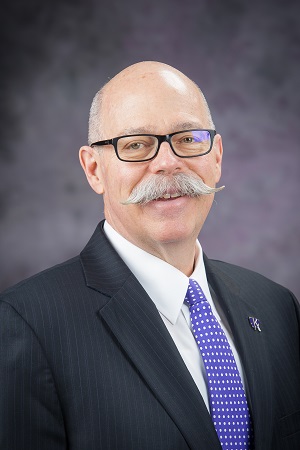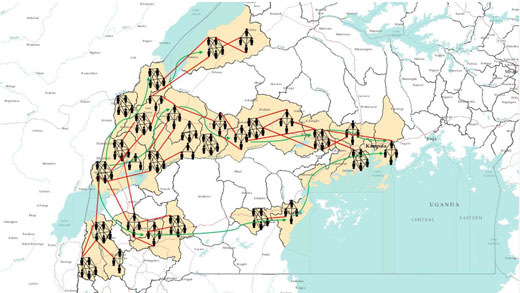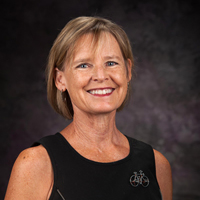07/11/19
K-State Current - July 11, 2019
K-State Current is a weekly news update for the Kansas Board of Regents to apprise the Regents on a few of the many successes and achievements made by K-State faculty, staff and students.

K-State News
Kansas State University names Ernie Minton dean of the College of Agriculture, KSRE director
 Leading the Kansas State University College of Agriculture and K-State Research and Extension into the future will be a familiar face. Ernie Minton, the interim dean and KSRE director, has been appointed to the posts following a national search.
Leading the Kansas State University College of Agriculture and K-State Research and Extension into the future will be a familiar face. Ernie Minton, the interim dean and KSRE director, has been appointed to the posts following a national search.
Minton's appointment, which went into effect June 16, was made by Charles Taber, university provost and executive vice president.
"The College of Agriculture and K-State Research and Extension are central to achieving our land-grant mission, and it's important we have balance and stability in this time of change," Taber said. "Based on his years of steady leadership as interim dean and director and associate dean and associate director, Dr. Minton is the right leader for the College and KSRE at this time."
As the college dean and KSRE director, Minton is charged with advancing both on a variety of fronts, including program development; faculty and student development; research, teaching and extension; program accreditation; and the college's and university's goals in K-State's visionary 2025 plan.
The College of Agriculture is home to more than 3,000 undergraduate and graduate students from across the U.S. and world and offers 16 undergraduate majors, 10 graduate programs, 14 minors and six certificates. The college's award-winning faculty conduct leading research in agricultural and horticultural crops, livestock, natural resources and the environment, earning multimillion-dollar grant totals each year. K-State Research and Extension is a statewide network of educators sharing unbiased, research-based information and expertise on issues important to Kansas. It has established local, state, regional, national and international partnerships.
"It has been a tremendous honor to serve as the interim dean and director, and I am thrilled to be selected as permanent dean and director," Minton said. "I'm proud to be a career K-Stater and to work with such a talented and loyal group of students, faculty and staff of the College of Agriculture and K-State Research and Extension. I look forward to moving the college and KSRE forward to embrace our traditions and build on our strengths to better serve our state, national and global stakeholders."
Minton had been serving as the interim college dean and KSRE director since July 1, 2018. Under his leadership, the college reached its Innovation & Inspiration Campaign goal of $120 million earlier this year. He also has led college-level planning for major infrastructure improvements and renovations to key college facilities, including Shellenberger Hall, Feed and Technology, Waters Hall and the Waters Hall Annex, as well as plans to modernize the diary teaching and research facility.
Before his appointment as interim dean, Minton served as the college's associate dean of research and graduate programs and associate director of research for K-State Research and Extension from 2016-2018. A professor of animal sciences since 1995 and a member of the Kansas State University faculty since 1983, Minton was interim associate director of research and technology transfer for the Kansas Agriculture Experiment Station from 2008-2009 and associate director of research and technology transfer for the Kansas Agricultural Experiment Station from 2009-2016.
Among his many honors and awards, Minton received the 2019 Wallace Kidd Diversity Award from the university's chapter of MANNRS — Minorities in Agriculture, Natural Resources and Related Sciences — and the College of Agriculture's Diversity Programs Office; 2017 Experiment Station National Excellence in Leadership Award from the North Central Regional Association of Experiment Station Directors; and was named a fellow of the Food Systems Leadership Institute in 2012.
Minton, who has served on several national and regional boards, is currently chair of the Strategic Realignment Committee for the Association of Public and Land-grant Universities' Board on Agricultural Assembly and is a member of the Kansas State University Research Foundation board of directors.
Minton has a bachelor's degree in agriculture from Western Kentucky University and a master's degree in animal science and a doctorate in animal reproduction, both from Oklahoma State University.
New transmission model for Ebola predicted latest Uganda cases

Kansas State University researchers have developed a multilayer temporal network model for how Ebola could spread in Uganda so health professionals can develop a risk assessment. They identified 23 districts at risk marked in beige. The human figures represent networks of constant contacts linked by black lines and temporary contacts linked by red lines. The green arrows represent the direction of human movement.
A new risk assessment model for the transmission of Ebola accurately predicted its spread into the Republic of Uganda, according to the Kansas State University researchers who developed it.
Caterina Scoglio, professor, and Mahbubul Riad, doctoral student, both in the Mike Wiegers Department of Electrical and Computer Engineering in the Carl R. Ice College of Engineering at Kansas State University; Musa Sekamatte and Issa Makumbi at Uganda Ministry of Health; and Felix Ocom with the World Health Organization in Uganda, published "Risk assessment of Ebola virus disease spreading in Uganda using a multilayer temporal network" in bioRxiv on May 23.
The paper describes a new model to better predict how diseases like Ebola spread. The model combines data of people's constant contacts — such as family members and co-workers — with their temporary contacts — such as people in a market or encountered during travel. According to Scoglio, the model should be used as a risk assessment tool to prepare and distribute resources, but it also has been accurate thus far regarding the movement of Ebola from the Democratic Republic of Congo into Uganda.
"This is very a new type of model," Scoglio said. "Since we consider movement data in addition to constant contacts, we saw that not only are the districts directly bordering Congo at risk but that the districts on the path to some important Ugandan destinations also are at risk."
In 2018, Scoglio and her collaborators worked with Ugandan officials to collect movement data to model disease progression and find areas most at risk. According to the model, the Kasese district was the highest risk area for an infected person to enter the country. The researchers used the model to create a 150-day simulation of possible disease progression in Uganda and produced a map of 23 Ugandan districts at risk.
The specific scenario used in the simulation is similar to actual events so far. According to the Uganda Health Ministry's June 18 release, there are three confirmed cases of Ebola in travelers to Uganda — all from one family that entered the country at the Kasese district border.
"The risk assessment maps can be used to allocate and distribute limited resources," Scoglio said. "Uganda has about 4,000 doses of the new Ebola vaccine. They are vaccinating health workers, communicating about how to prevent spreading diseases, and advising people to limit travel in high-risk areas. We have much respect and admiration for how Uganda has organized the preparedness and now the response."
The researchers used the simulation of Ebola in Uganda to test their model because there is a lot of traffic coming into the country from the Democratic Republic of Congo for health care, trading and refuge. Ebola is highly contagious through physical contact with an infected person and their bodily fluids.
Scoglio said that even though the real events in Uganda have aligned with the simulated model, the scenario should only be used to mitigate the risk.
"One very important point for the public to understand is the concept of risk and probability with these maps," Scoglio said. "It should not be interpreted that these red regions will be affected because that will cause panic in the population, but rather these are a guide for allocation of limited resources in regions that could be potentially affected if no mitigations are implemented."
This model may open a new era in infectious disease management, Scoglio said. She gives credit to Aram Vajdi, doctoral student in electrical and computer engineering at Kansas State University, for developing the framework for the theoretical model based on a multilayer temporal network and the Gillespie algorithm. Scoglio also praised Riad, who applied the data collected from Uganda and how Ebola was transmitted to create the risk assessment.
According to Scoglio, network models used for highly infectious disease risk assessment must be able to anticipate changes in human-to-human contacts — unlike many other models, which are based mainly on constant contacts and constant movement flows. Using these models can help increase the effectiveness of preventive measures by targeting the most critical regions and can help decrease the risk of Ebola and other infectious diseases from spreading.
K-State Faculty Highlights
Suprem Das' research team featured in physics journal
 Suprem Das, assistant professor of industrial and manufacturing systems engineering, is leading a research team studying the next generation of information carriers and storage units. Their research was recently featured on the cover of the Applied Physics Letter June 2019 issue. Industrial Engineering graduate student Aroop Behera of Das’ research group is the first author on the research paper.
Suprem Das, assistant professor of industrial and manufacturing systems engineering, is leading a research team studying the next generation of information carriers and storage units. Their research was recently featured on the cover of the Applied Physics Letter June 2019 issue. Industrial Engineering graduate student Aroop Behera of Das’ research group is the first author on the research paper.
Currently, silicon is the standard element used to manufacture computer chips and transistors, but the need for greater storage capacity and faster transmissions is leading scientists to explore other material options. Scientists have been exploring the possibility of using a quantum mechanical degree of freedom of an electron, called spin, instead of the charge which is used in electronics today. Although spin can store a massive amount of information compared to charge, manipulating and stabilizing spin within a material is notoriously difficult and yet to be achieved.
Das’ team believes the answer to these issues are called "skyrmions," an arrangement of atomic spins in a unique and topologically protected way. Since late 2018, the K-State team, led by Das, have asked the question: "If chromium tri-iodide is magnetic can there be a skyrmion in atomic thin magnet?" A concept they hypothesize as "2D-skyrmions."
In the article, the researchers show that under certain conditions, in particular, by applying a vertical electric field to the atomic magnet one can break the symmetry of their atomic positions that sufficiently induce favorable conditions to show swirling magnetic textures, i.e., skyrmions. These skyrmions have proven to be physically stable and can be used as information carriers. They could also be made very small — few tens of nanometers in size — and they are energy efficient when carrying information. So far skyrmions have been demonstrated in bulk materials and thin magnetic films when synthesized on heavy metals.
This work is a collaboration with Sugata Chowdhury, senior researcher and co-author at Rice University, who is presently stationed in NIST, Gaithersburg, Maryland. View the full article online.
Gayle Doll receives Distinguished Faculty Award from Gerontological Society of America
 Gayle Doll, associate professor and director of the Center on Aging, has been awarded the Distinguished Faculty Award from the Gerontological Society of America, the country's largest interdisciplinary organization devoted to the field of aging.
Gayle Doll, associate professor and director of the Center on Aging, has been awarded the Distinguished Faculty Award from the Gerontological Society of America, the country's largest interdisciplinary organization devoted to the field of aging.
The Distinguished Faculty Award recognizes a person whose teaching stands out as exemplary, innovative, of impact, or any combination thereof. Nominated by peers, the recipient’s achievements serve as milestones in the history and development of gerontology.
Doll joined the Center on Aging in 1998 as a graduate assistant and made her way through the ranks, being named director in 2008. Under her leadership, the center has increased funding and grown in both personnel and program offerings. She has increased her staff from three to 12, including the addition of a tenure-track assistant professor, a postdoc and multiple instructors. Students have seen an increase in course offerings through the center and the community has benefited through Doll's initiative to bring center staff into the community through programs, workshops and a satellite office in a Manhattan retirement community.
She has received numerous awards for her teaching, including the College of Health and Human Sciences' Myers-Alford Outstanding Teaching Award, the Commerce Bank Award for Outstanding Undergraduate Teaching and the Dayton Rothrock Award for Exceptional Teaching from McPherson College.
"Dr. Doll is an outstanding faculty member in the College of Health and Human Sciences," said John Buckwalter, dean of the college. "This award is well deserved. We are lucky to have her as the director of the Center on Aging here at K-State."
Doll will be recognized, along with 11 other award winners, at the society's 2019 Annual Scientific Meeting November 13-17 in Austin, Texas. For a full list of award winners, visit the society's website.
K-State Student News
K-State's chapter of Kappa Alpha Psi is the best in the Midwest
 The Kappa Alpha Psi chapter at K-State is the best in the Midwest. The fraternity has received the 2018-2019 Midwest Provincial Chapter of the Year.
The Kappa Alpha Psi chapter at K-State is the best in the Midwest. The fraternity has received the 2018-2019 Midwest Provincial Chapter of the Year.
Kappa Alpha Psi Fraternity Inc. was founded at the University of Indiana in 1911 and is dedicated to the principles of achievement through a truly domestic fraternity. The Provincial Chapter of the Year award is the highest honor Kappa Alpha Psi gives to a chapter in its Midwest province, which includes Kansas, Oklahoma, Colorado, Missouri, Nebraska and part of Arkansas. The chapter is now eligible to compete for Kappa Alpha Psi's National Chapter of the Year award, which is awarded in July. Last time the chapter received such award was in 2013.
The fraternity has participated in many service events on the Kansas State University campus and in the Manhattan community throughout the year, which helped to earn the Provincial Chapter the Year honor. Members have hosted study sessions and school supply and toy drives, participated in community cleanups and provided mentoring at the Douglass Community Center and the Manhattan Boys and Girls Club, among other activities.
Members of Kappa Alpha Psi at Kansas State University include:
Marking Daniels, December 2018 graduate in social sciences, Coffeyville.
From Kansas City: Christopher Hullaby, senior in psychology; Aaron Moore, senior in civil engineering; and Stephen Taylor, December 2018 graduate in fine arts.
Lyndon Breckenridge, December 2018 graduate in finance, Wichita.
From out of state: Jonah Haas, senior in communication studies, Kansas City, Missouri; Leonard McFadden, junior in mechanical engineering, Omaha, Nebraska; Dan Harris, December 2018 graduate in sociology, and Samuel Wilson, December 2018 graduate in vocal performance, both from Fort Worth, Texas; Sequille Franklin, senior in sociology, Dallas, Texas; and Jared Sterling, junior in finance, Houston, Texas.